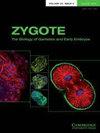由明显偏大的极体卵母细胞产生的活产:罕见病例报告
IF 1.4
4区 生物学
Q4 CELL BIOLOGY
引用次数: 0
摘要
在辅助生殖过程中,经常会出现第一极体(PB1)过大的卵母细胞。很多时候,这些卵母细胞未经人工授精就被丢弃,因此,迄今为止,有关这部分卵母细胞应用情况的报道很少。很少有研究对不孕妇女的大 PB1 卵母细胞进行研究,而且几乎完全是对大 PB1 卵母细胞异常的遗传变异进行研究。在这里,我们描述了一个不寻常的病例,即在冷冻胚胎移植(FET)周期中,一个非常大的 PB1 卵母细胞产生了一个活产婴儿。这是首例成功的活产案例,该活产案例中的 PB1 卵母细胞极体非常大,大小为 80 μM × 40 μM。这个大型 PB1 卵母细胞是通过早期卵胞浆内单精子显微注射(r-ICSI)获得的,并在第 5 天形成了一个囊胚。经过 FET,最终在受孕 37 周零 5 天时通过剖腹产诞下一名健康男婴,体重 3100 克。此外,这名足月分娩的婴儿在整个产前和围产期都没有出现并发症。这项研究首次揭示了巨大的 PB1 卵母细胞可以受精,导致囊胚生长、随后怀孕和活产。这一新信息促使我们重新考虑大型 PB1 卵母细胞的使用。由于并非所有形态异常的卵母细胞都不可用,因此应关注更多有见解的谈话,以防止胚胎的浪费。本文章由计算机程序翻译,如有差异,请以英文原文为准。
Live birth derived from a markedly large polar body oocyte: a rare case report
Oocytes with excessively large first polar bodies (PB1) often occur in assisted reproductive procedures. Many times these oocytes are discarded without insemination and, as a result, the application of this portion of oocytes has scarcely been reported to date. Few studies have examined large PB1 oocytes in infertile women and have virtually entirely studied genetic variations for large PB1 oocyte abnormalities. Here, we describe an unusual case of a live birth from a remarkably large PB1 oocyte in a frozen embryo transfer (FET) cycle. This is the first instance of a successful live birth resulting from a PB1 oocyte with an extremely large polar body measuring 80 μM × 40 μM in size. The large PB1 oocyte was performed by an early rescue intracytoplasmic sperm injection (r-ICSI) and was formed into a blastocyst on day 5. Following FET, a healthy boy baby weighing 3100 g was finally delivered by caesarean section at 37 weeks and 5 days after conception. Additionally, there were no complications throughout the antenatal period or the perinatal phase of this following full-term delivery. In this study, it is revealed for the first time that a huge PB1 oocyte can be fertilized, resulting in the growth of a blastocyst, a subsequent pregnancy, and a live birth. This new information prompts us to reconsider the use of large PB1 oocytes. More insightful talks should be given attention to prevent the waste of embryos because not all oocytes with aberrant morphology are unavailable.
求助全文
通过发布文献求助,成功后即可免费获取论文全文。
去求助
来源期刊

Zygote
生物-发育生物学
CiteScore
1.70
自引率
5.90%
发文量
117
审稿时长
6-12 weeks
期刊介绍:
An international journal dedicated to the rapid publication of original research in early embryology, Zygote covers interdisciplinary studies on gametogenesis through fertilization to gastrulation in animals and humans. The scope has been expanded to include clinical papers, molecular and developmental genetics. The editors will favour work describing fundamental processes in the cellular and molecular mechanisms of animal development, and, in particular, the identification of unifying principles in biology. Nonetheless, new technologies, review articles, debates and letters will become a prominent feature.
 求助内容:
求助内容: 应助结果提醒方式:
应助结果提醒方式:


